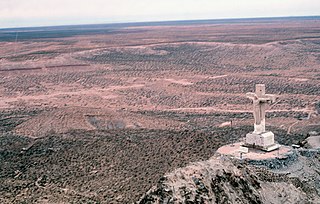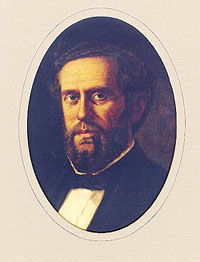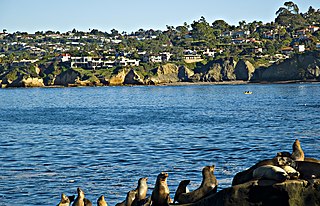Related Research Articles

Sunland Park is a city in southern Doña Ana County, New Mexico, United States, on the borders of Texas and the Mexican state of Chihuahua, with Ciudad Juárez adjoining it on the south and El Paso, Texas, on the east. The community of Santa Teresa adjoins it on the northwest. The population of Sunland Park was 14,106 at the 2010 census and was estimated at 17,978 by the United States Census Bureau in 2019. Though it lies adjacent to El Paso, being in Doña Ana County makes it a part of the Las Cruces metropolitan statistical area. Las Cruces is 42 miles (68 km) to the north.

Border control comprises measures taken by governments to monitor and regulate the movement of people, animals, and goods across land, air, and maritime borders. While border control is typically associated with international borders, it also encompasses controls imposed on internal borders within a single state.

The United States Border Patrol (USBP) is a federal law enforcement agency under the United States Customs and Border Protection (CBP) and is responsible for securing the borders of the United States. According to its web site in 2022, its mission is to "Protect the American people, safeguard our borders, and enhance the nation’s economic prosperity."

The Mexico–United States border wall is a series of vertical barriers along the Mexico–United States border intended to reduce illegal immigration to the United States from Mexico. The barrier is not a continuous structure but a series of obstructions variously classified as "fences" or "walls".

Enrique Roberto "Henry" Cuellar is an American attorney and politician serving as the U.S. representative for Texas's 28th congressional district since 2005. He is a member of the Democratic Party. His district extends from the Rio Grande to San Antonio's suburbs.

Michael Chertoff is an American attorney who was the second United States Secretary of Homeland Security to serve under President George W. Bush. Chertoff also served for one additional day under President Barack Obama. He was the co-author of the USA PATRIOT Act. Chertoff previously served as a United States circuit judge of the United States Court of Appeals for the Third Circuit, as a federal prosecutor, and as Assistant U.S. Attorney General. He succeeded Tom Ridge as U.S. Secretary of Homeland Security on February 15, 2005.

John Ireland was the 18th Governor of Texas from 1883 to 1887. During Ireland's term, the University of Texas was established, and construction on the Texas State Capitol began. Ireland is credited with the selection of local pink granite as the construction material.

The Mexico–United States border is an international border separating Mexico and the United States, extending from the Pacific Ocean in the west to the Gulf of Mexico in the east. The border traverses a variety of terrains, ranging from urban areas to deserts. The Mexico–U.S. border is the most frequently crossed border in the world with approximately 350 million documented crossings annually. It is the tenth-longest border between two countries in the world.
In the United States, a colonia is a type of unincorporated, low-income, slum area located along the Mexico–United States border region that emerged with the advent of shanty towns. These colonias consist of peri-urban subdivisions of substandard housing lacking in basic services such as potable water, electricity, paved roads, proper drainage, and waste management. Often situated in geographically inferior locations, such as former agricultural floodplains, colonias suffer from associated issues like flooding. Furthermore, urbanization practices have amplified the issues, such as when developers strip topsoil from the ground in order to subdivide land, the resulting plains become breeding grounds for mosquitoes and disease. Traditional homeownership financing methods are rare amongst colonias residents, and therefore these areas consist of ramshackle housing units built incrementally with found material on expanses of undeveloped land. Colonias have a predominant Latino population where 85 percent of those Latinos under the age of 18 are United States citizens. The U.S. has viewed border communities as a place of lawlessness, poverty, backwardness, and ethnic difference.

Falcon Dam is an earthen embankment dam on the Rio Grande between Starr County in the U.S. state of Texas and the city of Nueva Ciudad Guerrero in the Mexican state of Tamaulipas. The dam was built for water conservation, irrigation, hydroelectric power generation, flood control, and recreational purposes and as an international border crossing between Zapata and Starr Counties and Tamaulipas. Construction on the dam began in December 1950 and ended in April 1954 but it was dedicated by Mexican President Adolfo Ruiz Cortines and U.S. President Dwight D. Eisenhower in October 1953.

Loop 375 is a beltway that partially encircles the city of El Paso, Texas. The beltway is mostly a freeway, except for its northern section, which includes at-grade intersections. The highway passes through various areas of El Paso, funneling traffic within and around the city. The road is known locally under different names, as Woodrow Bean Transmountain Drive in the northern section, Purple Heart Memorial Freeway in the northeastern section, Joe Battle Boulevard in the eastern section, the César Chávez Border Highway in the southern section, and the Border West Expressway on the southwest section.

The Secure Fence Act of 2006, also labelled H.R. 6061, is an act of the United States Congress which authorized and partially funded the construction of 700 miles (1,125 km) of fencing along the Mexican border. The Act was signed into law on October 26, 2006, by U.S. President George W. Bush, who stated at the time that the Act would "help protect the American people", would "make our borders more secure", and was "an important step toward immigration reform".

San Diego–Tijuana is an international transborder agglomeration, straddling the border of the adjacent North American coastal cities of San Diego, California, United States, and Tijuana, Baja California, Mexico. The 2020 population of the region was 5,456,577, making it the largest bi-national conurbation shared between the United States and Mexico, and the second-largest shared between the US and another country. The conurbation consists of the San Diego metropolitan area, in the United States and the municipalities of Tijuana, Rosarito Beach (126,980), and Tecate (108,440) in Mexico. It is the third most populous region in the California–Baja California region, smaller only than the metropolitan areas of Greater Los Angeles and the San Francisco Bay Area.
Eloisa Garcia Tamez is an American civil rights leader, lecturer, professional nurse, professor and retired officer of the United States Army's Nursing Corps. She is a prominent opponent and litigant against the Texas-Mexico border wall. She self-identifies as being of Lipan Apache descent.

El Paso–Juárez, also known as Juárez–El Paso, the Borderplex or Paso del Norte, is a transborder agglomeration, on the border between Mexico and the United States. The region is centered on two large cities: Ciudad Juárez, Chihuahua, Mexico, and El Paso, Texas, U.S. Additionally, nearby Las Cruces, New Mexico, U.S., is sometimes included as part of the region, referred to as El Paso–Juárez–Las Cruces or El Paso–Juárez–Southern New Mexico. With over 2.7 million people, this binational region is the 2nd largest conurbation on the United States–Mexico border. The El Paso–Juárez region is the largest bilingual, binational work force in the Western Hemisphere.

The San Ysidro Port of Entry is the largest land border crossing between San Diego and Tijuana, and the fourth-busiest land border crossing in the world with 70,000 northbound vehicles and 20,000 northbound pedestrians crossing each day, in addition to southbound traffic. It connects Mexican Federal Highway 1 on the Mexican side with Interstate 5 on the American side. The San Ysidro Port of Entry is one of three ports of entry in the San Diego–Tijuana metropolitan region.
In United States immigration enforcement, "catch and release" refers to a practice of releasing a migrant to the community while he or she awaits hearings in immigration court, as an alternative to holding them in immigration detention. The migrants whom U.S. immigration enforcement agencies have allowed to remain in the community pending immigrant hearings have been those deemed low risk, such as children, families, and those seeking asylum.

The Trump wall, commonly referred to as "The Wall", is an expansion of the Mexico–United States barrier that started during the U.S. presidency of Donald Trump and was a critical part of Trump's 2016 presidential campaign platform leading up to the year's election. Throughout his campaign, Trump called for the construction of a border wall. He said that, if elected, he would "build the wall and make Mexico pay for it". Then–Mexican president Enrique Peña Nieto rejected Trump's claim that Mexico would pay for the wall; all construction in fact relied exclusively on U.S. funding.

The environmental impacts of the Mexico–United States border are numerous, including the disposal of hazardous waste, increase of air pollution, threats to essential water resources, and ecosystem fragmentation.
Several Indigenous peoples who live on the United States–Mexico border have objected to the construction of a border wall on their territories and the militarization of the border by the United States government. The US–Mexico border crosses several Indigenous territories and divides these communities. The barrier erected between the United States and Mexico cuts through and/or affects at least 29 Indigenous tribes, which include Kumeyaay Nation and Tohono O'odham.
References
- ↑ Stout, David. "Message From the Chairman". Texas Border Coalition. Retrieved 2024-01-15.
- ↑ POWELL, STEWART M. "Texas group sues to stop construction of border fence". Chron. Retrieved 2024-01-15.
- ↑ "TEXAS BORDER COALITION v. CHERTOFF et al". Justia Dockets & Filings. Retrieved 2024-01-15.
- ↑ Aguilar, Julián; Grissom, Brandi (2010-03-22). "Spillover Politics". The Texas Tribune. Retrieved 2024-01-15.
- ↑ Weissert, Will (May 6, 2011). "US increasing inspection posts at border bridge". Bloomberg Businessweek . Archived from the original on November 2, 2012.